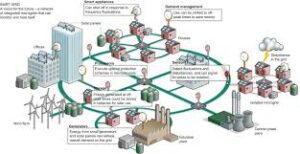Introduction:
Energy storage technology plays a pivotal role in our transition towards a sustainable and renewable energy future. As we strive to reduce greenhouse gas emissions and mitigate climate change, advancements in energy storage are essential for enhancing the efficiency, reliability, and affordability of renewable energy sources. In this blog, we’ll delve into the promising future of energy storage technology and the innovations shaping its trajectory.

Innovations are extending beyond earth, with energy storage playing a crucial role in space exploration. Enabling longer missions and more ambitious endeavors.
Lithium-ion Batteries: Beyond the Horizon:
Lithium-ion batteries have been a cornerstone of modern energy storage, powering an array of devices from smartphones to electric vehicles. However, the quest for better performance, safety, and sustainability is driving innovation beyond the confines of traditional lithium-ion technology.
Generation Materials:
Researchers are continuously refining the materials used in lithium-ion batteries to enhanc Researchers are continuously refining the materials used in lithium-ion batteries to enhance their performance and durability.

Silicon anodes, for example, offer significantly higher energy density than conventional graphite anodes, promising longer-lasting and more powerful batteries. Advancements in cathode materials, such as nickel-rich compositions, are increasing energy density and reducing costs, paving the way for more affordable electric vehicles and grid-scale storage solutions.
Solid-State Batteries:
Solid-state batteries represent a paradigm shift in energy storage technology, offering improved safety, energy density, and lifespan compared to liquid electrolyte counterparts.
By replacing the flammable liquid electrolyte with a solid-state electrolyte, these batteries eliminate the risk of thermal runaway and enhance reliability.
Companies like QuantumScape and Solid Power are pioneering solid-state battery technology, aiming to commercialize batteries with higher energy density and faster charging capabilities.
Recycling and Sustainability:
As the demand for lithium-ion batteries continues to grow, ensuring the sustainability of battery production and disposal is paramount.
Innovations in battery recycling technologies are enabling the recovery of valuable materials like lithium, cobalt, and nickel, reducing the environmental impact of battery manufacturing.
Closed-loop recycling processes are being developed to recover and reuse battery materials, creating a more circular economy for lithium-ion batteries.
Beyond Energy Storage:
Lithium-ion batteries are not only powering our devices and vehicles but also enabling the integration of renewable energy sources into the grid.
Battery energy storage systems (BESS) paired with solar and wind farms are providing grid stability, balancing supply and demand fluctuations, and facilitating the transition to a renewable energy future.
The horizon for lithium-ion batteries is vast and filled with possibilities. From next-generation materials to solid-state technology and sustainability initiatives,
Flow Batteries: Unleashing Scalable Storage Solutions:
Flow batteries have emerged as a promising technology for scalable energy storage solutions, offering unique advantages over traditional lithium-ion batteries. Flow batteries represent a compelling solution for scalable energy storage, offering advantages such as long-duration capabilities, scalability, and enhanced safety

How Flow Batteries Work:
Unlike conventional batteries, which store energy in solid electrodes, flow batteries utilize liquid electrolytes stored in external tanks.
During charging and discharging, electrolytes flow through a cell stack, where electrochemical reactions occur, generating or consuming electrical energy.
Vanadium Redox Flow Batteries (VRFBs):
Among the most prominent types of flow batteries are vanadium redox flow batteries (VRFBs), which use vanadium ions in different oxidation states as electrolytes.
VRFBs offer several advantages, including long cycle life, rapid response times, and high efficiency over a wide range of operating conditions.
Advancements and Innovations:
Ongoing research and development efforts are focused on improving the performance and reducing the cost of flow battery systems.
Innovations in membrane technology, electrode materials, and electrolyte formulations are driving efficiency gains and extending the operational lifespan of flow batteries.
Grid-Scale Applications:
Flow batteries are ideally suited for grid-scale energy storage applications, where their scalability and long-duration capabilities provide valuable grid services.
Paired with renewable energy sources like solar and wind, flow batteries help mitigate intermittency and variability, enhancing grid stability and reliability.
Beyond Batteries: Exploring Novel Energy Storage Concepts:
While batteries have been at the forefront of energy storage solutions, a wave of innovation is ushering in a new era of diverse and unconventional approaches to storing energy.

In this section, we embark on a journey to explore novel energy storage concepts that transcend the traditional confines of batteries, offering unique advantages and opportunities for a sustainable energy future.
Hydrogen Storage:
Hydrogen storage represents a promising avenue for long-duration energy storage and grid balancing.
Electrolysis processes convert surplus renewable energy into hydrogen gas, which can be stored in tanks or underground caverns.
Compressed Air Energy Storage (CAES):
CAES systems store energy by compressing air into underground caverns or storage tanks.
During periods of high energy demand, the compressed air is released and expanded through turbines to generate electricity.
Flywheel Energy Storage:
Flywheel energy storage systems harness the kinetic energy of a spinning rotor to store and release energy.When excess electricity is available, the rotor is accelerated, storing energy in its rotational motion.
Thermal Energy Storage:
Thermal energy storage leverages the heat capacity of materials to store and release energy.
Phase change materials, such as molten salts or ice, absorb or release heat during phase transitions, providing a means of storing energy from renewable sources like solar thermal systems.
Gravity Storage:
Gravity storage systems utilize the potential energy of raised masses, such as heavy weights or water, to store energy.
During periods of excess electricity, the mass is lifted to a higher elevation, converting electrical energy into gravitational potential energy.
Integration and Smart Grids: Optimizing Energy Storage Deployment:
In an era of increasing renewable energy penetration and growing energy demand, optimizing the deployment of energy storage systems is essential for enhancing grid stability, reliability, and efficiency. Integration with smart grids holds the key to unlocking the full potential of energy storage technologies. In this section, we explore the synergies between energy storage deployment and smart grid optimization strategies.
Grid Stability and Resilience:
Energy storage systems play a critical role in maintaining grid stability by providing frequency regulation, voltage support, and rapid response to grid disturbances.By absorbing excess energy during periods of high generation and releasing stored energy during demand spikes or supply shortages, energy storage helps balance the grid in real-time.
Renewable Energy Integration:
The intermittent nature of renewable energy sources like solar and wind presents challenges for grid operators in matching supply with demand. Energy storage systems facilitate the integration of renewables by storing surplus energy during periods of high generation and releasing it when demand exceeds supply.
Demand-Side Management:
Energy storage deployment can be leveraged for demand-side management strategies, such as peak shaving and load shifting.
By storing excess energy during off-peak hours and discharging it during peak demand periods, energy storage systems help reduce strain on the grid and lower electricity costs.
Grid Optimization and Forecasting:
Advanced analytics and forecasting algorithms empower grid operators to optimize the deployment and operation of energy storage assets.
Predictive modeling techniques analyze historical data and weather patterns to anticipate future energy demand and generation, enabling proactive storage management.
Conclusion:
The future of energy storage technology holds immense promise, driven by relentless innovation and a growing commitment to sustainability. From advanced lithium-ion batteries to flow batteries and novel storage concepts, the landscape is evolving rapidly, offering solutions tailored to diverse applications and scale. By harnessing these technologies and integrating them intelligently into our energy infrastructure, we can accelerate the transition towards a cleaner, more resilient energy future.

